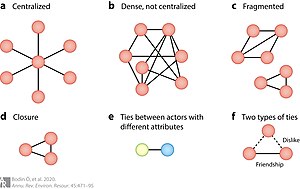Signed network

In a social network analysis (as in blockmodeling), a positive or a negative 'friendship' can be established between two nodes in a network; this results in a signed network. As social interaction between people can be positive or negative, so can be links between the nodes (representing persons).[1]
When a positive or a negative value is attributed on the relationship between the two nodes, it is called a user evaluation.[2] In social groups, people can like or dislike, respect or disrespect other people in their social groups.[3]
The quality of such connections can be further analysed, as a positive connections can have a positive influence on the whole network (one person on social group or society in general) and vice versa.[4]
When network connections are not evaluated between the nodes (e.g., all connections are regarded as positive - as they exist), then such a network is defined as an unsigned network.[5]
References[]
- ^ Geeksforgeeks.org - Signed Networks in Social Networks
- ^ Raj, P. M. K.; Mohan, A.; Srinivasa, K. G. (2018). "Signed Networks". Practical Social Network Analysis with Python. Computer Communications and Networks. Springer. doi:10.1007/978-3-319-96746-2_7. ISBN 978-3-319-96746-2.
- ^ Doreian, Patrick; Mrvar, Andrej (2009). "Partitioning signed social networks". Social Networks. 31 (1): 1–11. doi:10.1016/j.socnet.2008.08.001.
- ^ Esmailian, Pouya; Jalili, Mahdi (2015). "Community Detection in Signed Networks: the Role of Negative ties in Different Scales". Scientific Reports. 5 (14339). doi:10.1038/srep14339. PMC 4585820.
- ^ Peter Langfelder - Signed or unsigned: which network type is preferable?
See also[]
- Signed graph
- Balance theory
- Social network analysis